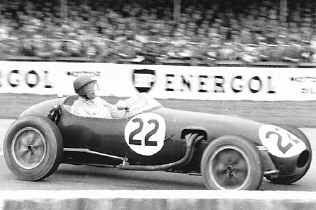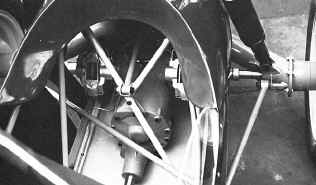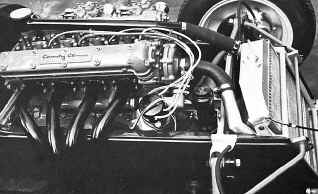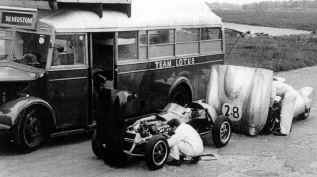|
Colin Chapman’s long-held wish to build and
enter one of his cars in Grand Prix racing finally came to be with the
Lotus 12, the beginning of the line of open-wheelers that eventually won
seven F-1 constructors championships.
In 1956 the FIA announced a new Formula 2 regulation to be enacted the
following year. In the UK
it was decided to begin racing immediately under the new rules with cars
already in existence, most of those being Lotus Elevens.
But Chapman quickly drew up a new single-seat design and had a
Lotus 12 prototype on display at the London Motor Show in October.
The prototype was meant strictly for show, with a wooden
transaxle, a frame with hardly any weld-metal, just enough room for a
non-functional Climax FPF, and highly cambered deDion rear suspension.
Woe to anyone who copied this much-photographed
and very defective example!
Viewed from the side, the frame of the 12 had clear relationship to the
Eleven, but with a more sharply raked seatback angle and inverted
triangulation to the cockpit. The
plan view was of an exceptionally narrow car: the frame barely wide
enough for the engine and the driver’s shoulders. In all a tiny package, with the driver sandwiched between the
Climax FPF and a rear-mounted transmission.
It was expected that 150 h.p. could be harnessed in just 620 lbs.
of race car. Chapman’s
philosophy of economical use of space and mass was at, or beyond, its
practical limits.
At the front the prototype had an innovation that had been on
Chapman’s mind for months: a
new twin- wishbone suspension here made its debut, replacing the infamous
Lotus swing-axle. The new
suspension incorporated an anti-roll bar that played double-duty as the
forward half of the top wishbone. This
setup became a mainstay of various Lotus cars for many years.
The 12 also introduced the ‘wobble web’ alloy wheel, another
of Chapman’s initiatives, but made to work by designer ‘Mac’
McIntosh. However,
many features of the prototype were not seen again, as production models
were improved with better chassis and Chapman’s first use of
strut-type suspension at the rear.
The 12 was largely unsuccessful as an F2 or an F-1 machine although in
the hands of Cliff Allison it had some fine moments and nearly won at
Spa in the ’58 GP. But it
and the later type 16 also helped give Lotus a reputation for
fragile and unreliable performance.
While performing in high-visibility events was Chapman’s dream,
failures in front of those audiences were hard for everyone to
forget.
What the 12 did for the Eleven was to force some attention onto ways the
Eleven could be improved for more horsepower and higher speeds.
It preceded the Eleven Series 2 by several months and lent some
of these innovations – with more successful results – to the
sports-racer.
Readers wishing to learn more about the prototype Lotus 12 should locate
issues #40 & #41 of Historic Lotus, with very interesting articles
by Mike Bennett and David Morgan. |




